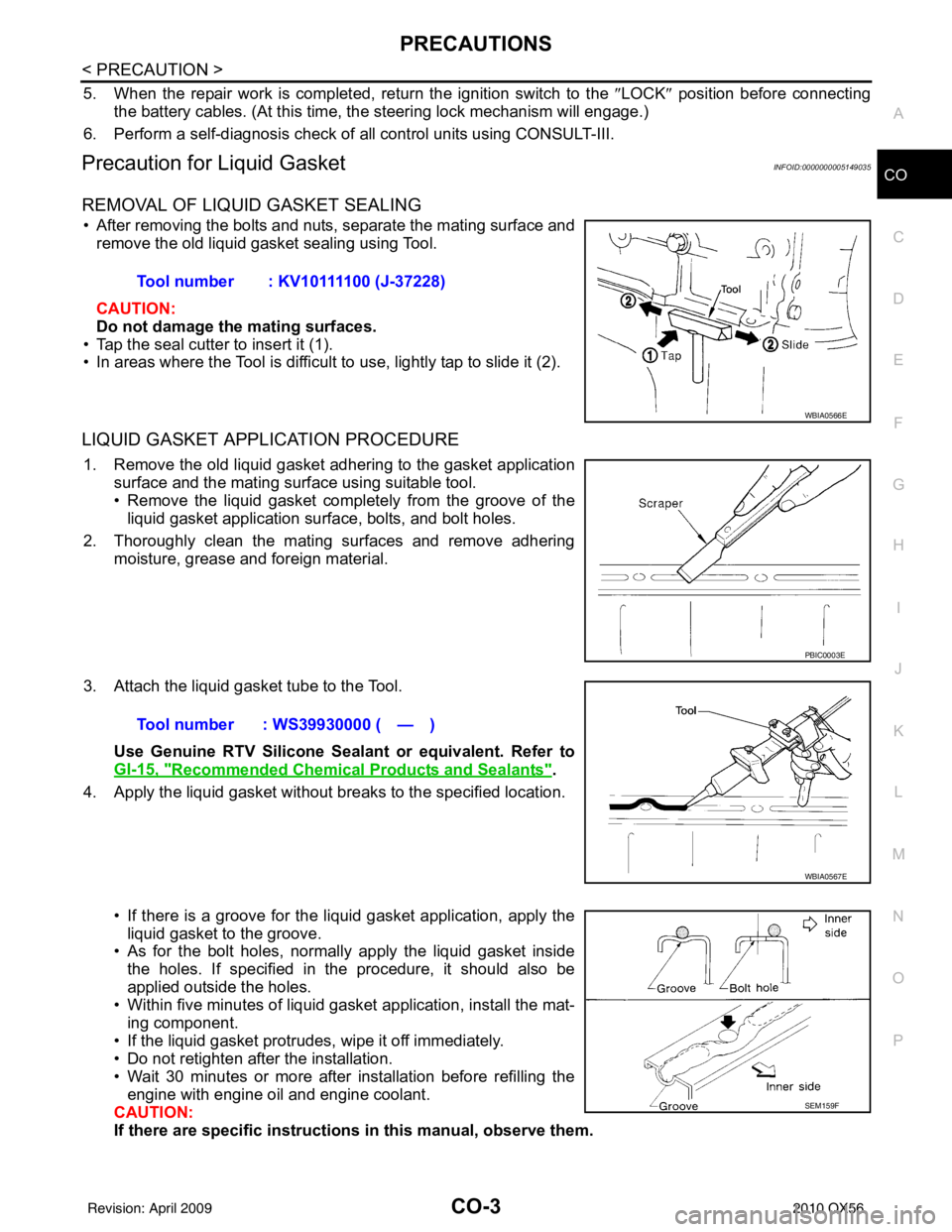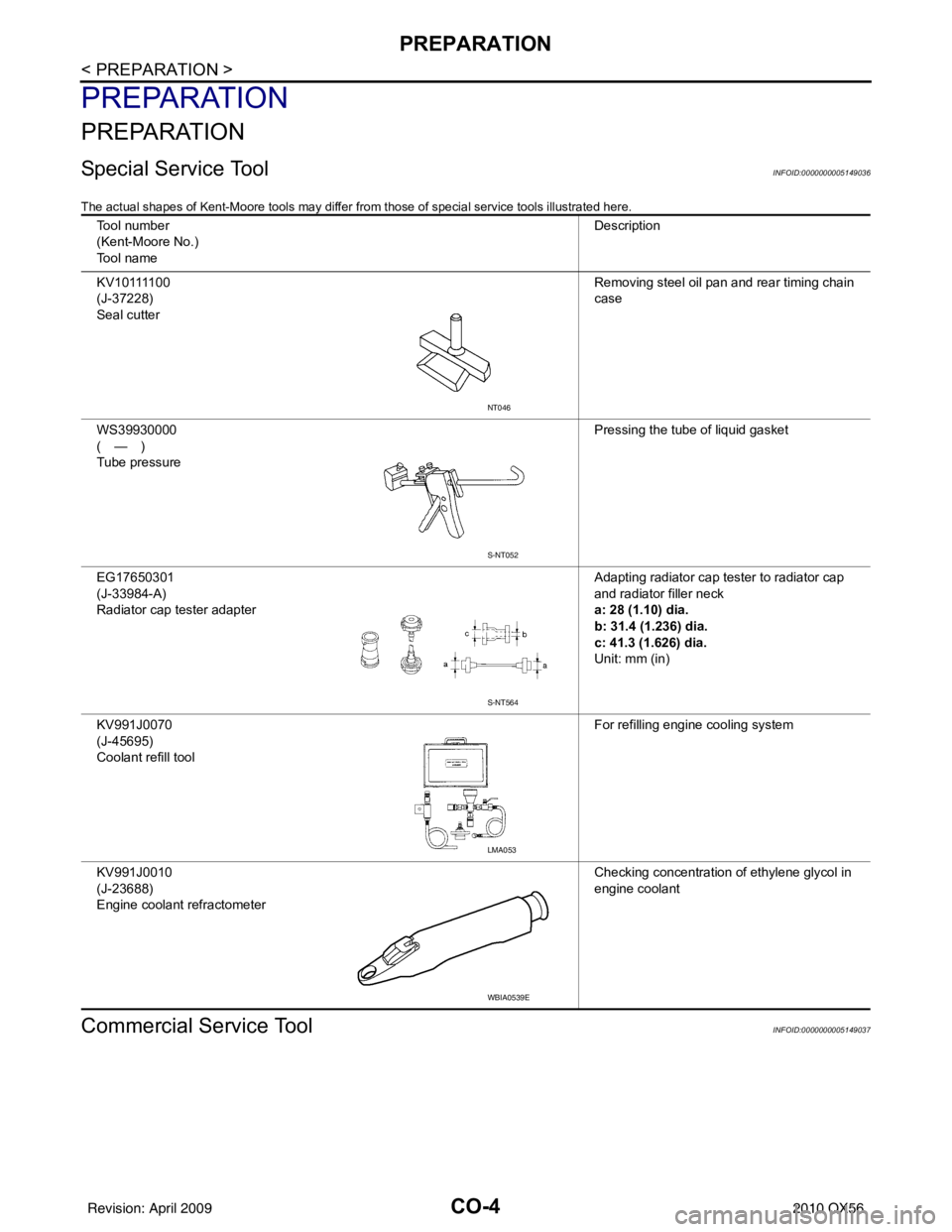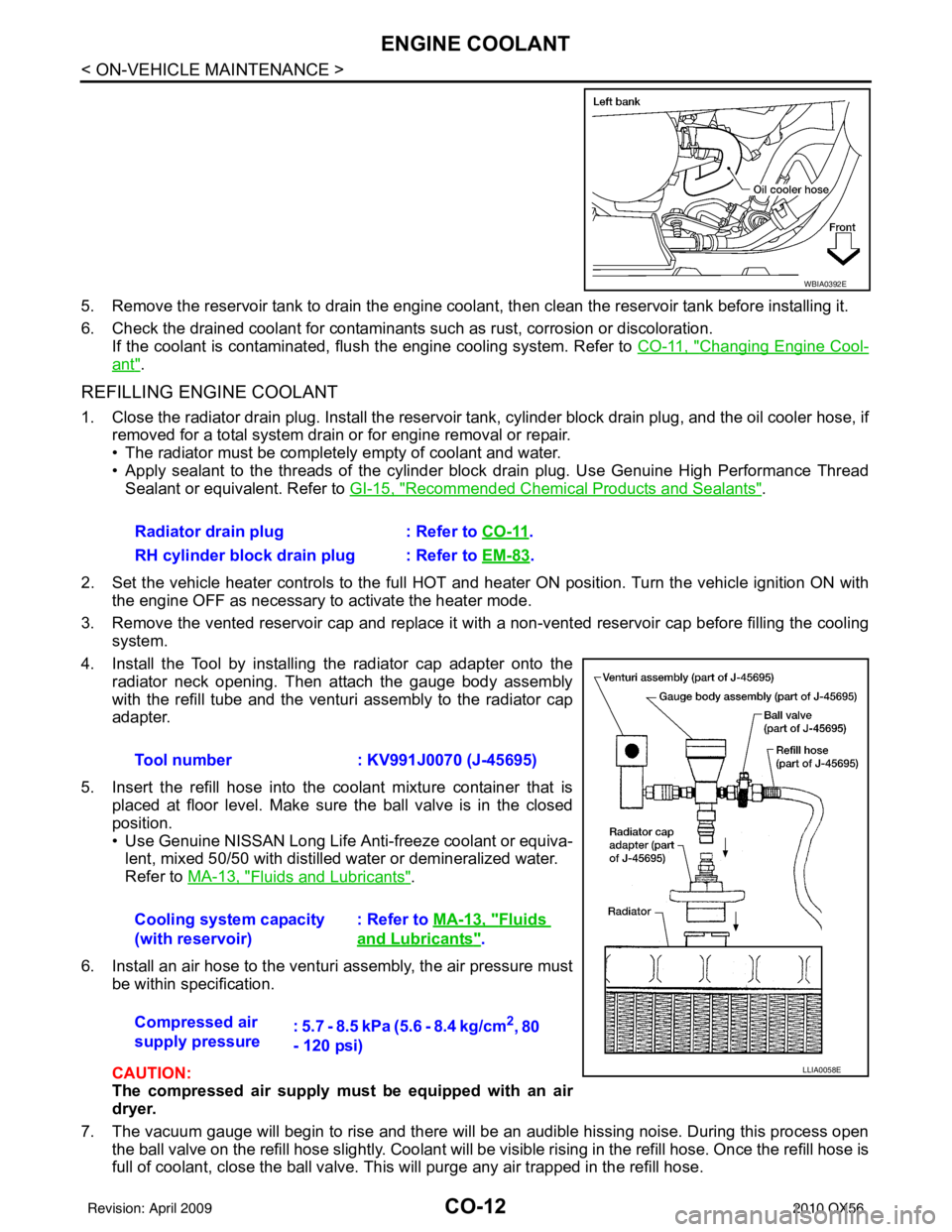check oil INFINITI QX56 2010 Factory User Guide
[x] Cancel search | Manufacturer: INFINITI, Model Year: 2010, Model line: QX56, Model: INFINITI QX56 2010Pages: 4210, PDF Size: 81.91 MB
Page 767 of 4210

PRECAUTIONSCO-3
< PRECAUTION >
C
DE
F
G H
I
J
K L
M A
CO
NP
O
5. When the repair work is completed, return the ignition switch to the
″LOCK ″ position before connecting
the battery cables. (At this time, the steering lock mechanism will engage.)
6. Perform a self-diagnosis check of al l control units using CONSULT-III.
Precaution for Liquid GasketINFOID:0000000005149035
REMOVAL OF LIQUID GASKET SEALING
• After removing the bolts and nuts, separate the mating surface and
remove the old liquid gasket sealing using Tool.
CAUTION:
Do not damage the mating surfaces.
• Tap the seal cutter to insert it (1).
• In areas where the Tool is difficult to use, lightly tap to slide it (2).
LIQUID GASKET APPLICATION PROCEDURE
1. Remove the old liquid gasket adhering to the gasket application surface and the mating surface using suitable tool.
• Remove the liquid gasket completely from the groove of the
liquid gasket application surface, bolts, and bolt holes.
2. Thoroughly clean the mating surfaces and remove adhering moisture, grease and foreign material.
3. Attach the liquid gasket tube to the Tool. Use Genuine RTV Silicone Sealant or equivalent. Refer to
GI-15, "
Recommended Chemical Products and Sealants".
4. Apply the liquid gasket without breaks to the specified location.
• If there is a groove for the liquid gasket application, apply theliquid gasket to the groove.
• As for the bolt holes, normally apply the liquid gasket inside
the holes. If specified in the procedure, it should also be
applied outside the holes.
• Within five minutes of liquid gasket application, install the mat-
ing component.
• If the liquid gasket protrudes, wipe it off immediately.
• Do not retighten after the installation.
• Wait 30 minutes or more after installation before refilling the engine with engine oil and engine coolant.
CAUTION:
If there are specific instructions in this manual, observe them.
Tool number : KV10111100 (J-37228)
WBIA0566E
PBIC0003E
Tool number : WS39930000 ( — )
WBIA0567E
SEM159F
Revision: April 20092010 QX56
Page 768 of 4210

CO-4
< PREPARATION >
PREPARATION
PREPARATION
PREPARATION
Special Service ToolINFOID:0000000005149036
The actual shapes of Kent-Moore tools may differ from those of special service tools illustrated here.
Commercial Service ToolINFOID:0000000005149037
Tool number
(Kent-Moore No.)
Tool name Description
K V 1 0 1111 0 0
(J-37228)
Seal cutter Removing steel oil pan and rear timing chain
case
WS39930000
(—)
Tube pressure Pressing the tube of liquid gasket
EG17650301
(J-33984-A)
Radiator cap tester adapter Adapting radiator cap tester to radiator cap
and radiator filler neck
a: 28 (1.10) dia.
b: 31.4 (1.236) dia.
c: 41.3 (1.626) dia.
Unit: mm (in)
KV991J0070
(J-45695)
Coolant refill tool For refilling engine cooling system
KV991J0010
(J-23688)
Engine coolant refractometer Checking concentration of ethylene glycol in
engine coolant
NT046
S-NT052
S-NT564
LMA053
WBIA0539E
Revision: April 20092010 QX56
Page 776 of 4210

CO-12
< ON-VEHICLE MAINTENANCE >
ENGINE COOLANT
5. Remove the reservoir tank to drain the engine coolant, then clean the reservoir tank before installing it.
6. Check the drained coolant for contaminants such as rust, corrosion or discoloration.
If the coolant is contaminated, flus h the engine cooling system. Refer to CO-11, "
Changing Engine Cool-
ant".
REFILLING ENGINE COOLANT
1. Close the radiator drain plug. Install the reservoir t ank, cylinder block drain plug, and the oil cooler hose, if
removed for a total system drain or for engine removal or repair.
• The radiator must be completely empty of coolant and water.
• Apply sealant to the threads of the cylinder bl ock drain plug. Use Genuine High Performance Thread
Sealant or equivalent. Refer to GI-15, "
Recommended Chemical Products and Sealants".
2. Set the vehicle heater controls to the full HOT and heat er ON position. Turn the vehicle ignition ON with
the engine OFF as necessary to activate the heater mode.
3. Remove the vented reservoir cap and replace it with a non-vented reservoir cap before filling the cooling
system.
4. Install the Tool by installing the radiator cap adapter onto the radiator neck opening. Then attach the gauge body assembly
with the refill tube and the venturi assembly to the radiator cap
adapter.
5. Insert the refill hose into the coolant mixture container that is placed at floor level. Make sure the ball valve is in the closed
position.
• Use Genuine NISSAN Long Life Anti-freeze coolant or equiva-lent, mixed 50/50 with distilled water or demineralized water.
Refer to MA-13, "
Fluids and Lubricants".
6. Install an air hose to the venturi assembly, the air pressure must be within specification.
CAUTION:
The compressed air supply must be equipped with an air
dryer.
7. The vacuum gauge will begin to rise and there will be an audible hissing noise. During this process open the ball valve on the refill hose slightly. Coolant will be vi sible rising in the refill hose. Once the refill hose is
full of coolant, close the ball valve. This will purge any air trapped in the refill hose.
WBIA0392E
Radiator drain plug : Refer to CO-11.
RH cylinder block drain plug : Refer to EM-83
.
Tool number : KV991J0070 (J-45695)
Cooling system capacity
(with reservoir) : Refer to
MA-13, "
Fluids
and Lubricants".
Compressed air
supply pressure : 5.7 - 8.5 kPa (5.6 - 8.4 kg/cm
2, 80
- 120 psi)
LLIA0058E
Revision: April 20092010 QX56
Page 781 of 4210

RADIATORCO-17
< ON-VEHICLE REPAIR >
C
DE
F
G H
I
J
K L
M A
CO
NP
O
12. Lift up and remove the radiator.
CAUTION:
Do not damage or scratch air conditioner condenser, A/T oil
cooler or radiator core when removing.
INSTALLATION
Installation is in the reverse order of removal.
INSPECTION AFTER INSTALLATION
• Check for leaks of engine coolant. Refer to CO-10, "Inspection".
• Start and warm up the engine. Visually check for leaks of the engine coolant and A/T fluid.
PBIC1536E
Revision: April 20092010 QX56
Page 782 of 4210

CO-18
< ON-VEHICLE REPAIR >
ENGINE COOLING FAN
ENGINE COOLING FAN
Exploded ViewINFOID:0000000005149046
Crankshaft Driven Type
Removal and Installation (Crankshaft Driven Type)INFOID:0000000005149047
REMOVAL
1. Partially drain engine coolant from the radiator. Refer to CO-11, "Changing Engine Coolant".
2. Remove the lower and upper radiator shrouds. Refer to CO-15, "
Exploded View".
3. Remove the drive belt. Refer to EM-13, "
Removal and Installation".
4. Remove the cooling fan.
5. Remove the fan bracket, if necessary.
INSPECTION AFTER REMOVAL
Fan Coupling
• Inspect fan coupling for oil leakage and bimetal conditions.
• If there are any unusual concerns, replace the fan coupling.
Fan Bracket
• Visually check that there is no significant looseness in the fan bracket shaft, and that it turns smoothly by hand.
• If there are any unusual concerns, replace the fan bracket.
Cooling Fan Pulley
• Inspect cooling fan pulley.
• If there are any unusual concerns, replace the cooling fan pulley.
AWBIA0812GB
1. Cooling fan 2. Fan coupling3. Fan bracket
4. Cooling fan pulley A. Front mark Engine front
SLC072
WBIA0418E
Revision: April 20092010 QX56
Page 833 of 4210

REAR WINDOW DEFOGGERDEF-45
< ON-VEHICLE REPAIR >
C
DE
F
G H
I
J
K
M A
B
DEF
N
O P
ON-VEHICLE REPAIR
REAR WINDOW DEFOGGER
Filament CheckINFOID:0000000005146857
1. When measuring voltage, wrap tin foil around the top of the neg- ative probe.Then press the foil against the wire with your finger.
2. Attach probe circuit tester (in Volt range) to middle portion of each filament.
3. If a filament is burned out, circuit tester registers 0 or battery voltage.
4. To locate burned out point, move probe to left and right along fil- ament. Test needle will swing abruptly when probe passes the
point.
Filament RepairINFOID:0000000005146858
REPAIR EQUIPMENT
• Conductive silver composition (DuPont No. 4817 or equivalent)
• Ruler 30 cm (11.8 in) long
SEL122R
SEL263
SEL265
Revision: April 20092010 QX56
Page 1070 of 4210
![INFINITI QX56 2010 Factory User Guide DLK-236
< ON-VEHICLE REPAIR >[WITH INTELLIGENT KEY SYSTEM]
HOOD
4. Install the primary and secondary cables securely to the hood
lock assembly.
5. Install the hood lock and the secondary hood lock rel INFINITI QX56 2010 Factory User Guide DLK-236
< ON-VEHICLE REPAIR >[WITH INTELLIGENT KEY SYSTEM]
HOOD
4. Install the primary and secondary cables securely to the hood
lock assembly.
5. Install the hood lock and the secondary hood lock rel](/img/42/57032/w960_57032-1069.png)
DLK-236
< ON-VEHICLE REPAIR >[WITH INTELLIGENT KEY SYSTEM]
HOOD
4. Install the primary and secondary cables securely to the hood
lock assembly.
5. Install the hood lock and the secondary hood lock release assemblies.
6. Check the hood lock adjustment and hood opener operation. Refer to DLK-233, "
Fitting Adjustment".
7. Install the remaining components in the reverse order of removal.
Hood Lock Control InspectionINFOID:0000000005147053
CAUTION:
If the hood lock cable is bent or deformed, replace it.
1. Remove the front grille. Refer to EXT-17, "
Removal and Installation".
2. Make sure the secondary latch is properly engaged with the sec- ondary striker with hood's own weight by dropping it from
approx. 200 mm (7.87 in) height.
3. While operating the hood opener, carefully make sure the front end of the hood is raised by approx. 20 mm (0.79 in). Also make
sure the hood opener returns to the original position.
4. Check the hood lock lubrication condition. If necessary, apply “body grease” to the points shown in the figure.
5. Install the front grille. Refer to EXT-17, "
Removal and Installa-
tion".
Hood Stay DisposalINFOID:0000000005356855
1. Fix hood stay (1) using a vise (C).
2. Using hacksaw (A) slowly make 2 holes in the hood stay, in numerical order as shown in the figure.
CAUTION:
• When cutting a hole on hood stay, always cover a hack-saw using a shop cloth (B) to avoid scattering metal frag-
ments or oil.
• Wear eye protection (safety glasses).
• Wear gloves.
PIIA0174E
PIIA1086E
PIIA0176E
JMKIA3336ZZ
Revision: April 20092010 QX56
Page 1086 of 4210

DLN-4
Commercial Service Tool ......................................193
SYMPTOM DIAGNOSIS ............................194
NOISE, VIBRATION, AND HARSHNESS
(NVH) TROUBLESHOOTING ......................... .
194
NVH Troubleshooting Chart ................................ ..194
ON-VEHICLE REPAIR ...............................195
PROPELLER SHAFT ..................................... .195
On-Vehicle Service .............................................. ..195
REMOVAL AND INSTALLATION ..............196
PROPELLER SHAFT ..................................... .196
Removal and Installation ..................................... ..196
DISASSEMBLY AND ASSEMBLY ............199
PROPELLER SHAFT ..................................... .199
Disassembly and Assembly ................................. ..199
SERVICE DATA AND SPECIFICATIONS
(SDS) ........................................................ ..
201
SERVICE DATA AND SPECIFICATIONS
(SDS) ............................................................... .
201
General Specification .......................................... ..201
Snap Ring ..............................................................201
FRONT FINAL DRIVE: M205
PRECAUTION .............. ..............................
203
PRECAUTIONS .............................................. .203
Precaution for Supplemental Restraint System
(SRS) "AIR BAG" and "SEAT BELT PRE-TEN-
SIONER" .............................................................. ..
203
Precaution Necessary for Steering Wheel Rota-
tion After Battery Disconnect .................................
203
Precaution for Servicing Front Final Drive .............204
PREPARATION ..........................................205
PREPARATION .............................................. .205
Special Service Tool ............................................ ..205
Commercial Service Tool ......................................207
SYMPTOM DIAGNOSIS ............................208
NOISE, VIBRATION AND HARSHNESS
(NVH) TROUBLESHOOTING ......................... .
208
NVH Troubleshooting Chart ................................ ..208
ON-VEHICLE MAINTENANCE ..................209
DIFFERENTIAL GEAR OIL ............................ .209
Changing Front Differential Gear Oil .....................209
Checking Front Differential Gear Oil .................... ..209
ON-VEHICLE REPAIR ...............................210
SIDE OIL SEAL .............................................. ..210
Removal and Installation .......................................210
FRONT OIL SEAL ............................................211
Removal and Installation .......................................211
CARRIER COVER .......................................... ..214
Removal and Installation .......................................214
REMOVAL AND INSTALLA TION .............215
FRONT FINAL DRIVE .................................... ..215
Removal and Installation .......................................215
DISASSEMBLY AND ASSEMBLY ...........217
FRONT FINAL DRIVE .................................... ..217
Disassembly and Assembly ................................. .217
SERVICE DATA AND SPECIFICATIONS
(SDS) ........ .................................................
234
SERVICE DATA AND SPECIFICATIONS
(SDS) .............................................................. ..
234
General Specification ........................................... .234
Inspection and Adjustment ....................................234
REAR FINAL DRIVE: R230
PRECAUTION ............... ............................
236
PRECAUTIONS .............................................. ..236
Precaution for Supplemental Restraint System
(SRS) "AIR BAG" and "SEAT BELT PRE-TEN-
SIONER" .............................................................. .
236
Precaution Necessary for Steering Wheel Rota-
tion After Battery Disconnect ................................
236
Precaution for Servicing Rear Final Drive .............237
PREPARATION .........................................238
PREPARATION .............................................. ..238
Special Service Tool ............................................ .238
Commercial Service Tool ......................................240
SYMPTOM DIAGNOSIS ...........................242
NOISE, VIBRATION AND HARSHNESS
(NVH) TROUBLESHOOTING ......................... ..
242
NVH Troubleshooting Chart ..................................242
DESCRIPTION ................................................ ..243
Cross-Sectional View ........................................... .243
ON-VEHICLE MAINTENANCE .................244
DIFFERENTIAL GEAR OIL ..............................244
Changing Rear Differential Gear Oil .................... .244
Checking Rear Differential Gear Oil ......................244
ON-VEHICLE REPAIR ..............................245
FRONT OIL SEAL ............................................245
Revision: April 20092010 QX56
Page 1096 of 4210
![INFINITI QX56 2010 Factory User Guide DLN-14
< FUNCTION DIAGNOSIS >[ATX14B]
4WD SYSTEM
• Displays 4LO condition while engine is running. 4LO indicator lamp flashes if transfer gear does not shift
completely under 2WD, AUTO, 4H ⇔4LO. ( INFINITI QX56 2010 Factory User Guide DLN-14
< FUNCTION DIAGNOSIS >[ATX14B]
4WD SYSTEM
• Displays 4LO condition while engine is running. 4LO indicator lamp flashes if transfer gear does not shift
completely under 2WD, AUTO, 4H ⇔4LO. (](/img/42/57032/w960_57032-1095.png)
DLN-14
< FUNCTION DIAGNOSIS >[ATX14B]
4WD SYSTEM
• Displays 4LO condition while engine is running. 4LO indicator lamp flashes if transfer gear does not shift
completely under 2WD, AUTO, 4H ⇔4LO. (When 4WD warning lamp is turned on, 4LO indicator lamp is
turned off.)
• Turns ON for approximately 1 second when ignition switch is turned ON, for purpose of lamp check.
4WD WARNING LAMP
Turns on or flashes when there is a malfunction in 4WD system.
Also turns on when ignition switch is turned ON, for purpose of lamp che\
ck. Turns OFF approximately 1 sec-
ond after the engine starts if system is normal.
4WD Warning Lamp Indication
ATP WARNING LAMP
When the A/T selector lever is in P position, the vehicle may move if the transfer case is in neutral. ATP warn-
ing lamp is turned on to indicate this condition to the driver.
LINE PRESSURE SWITCH
• With the transfer system design, control of the oil pressure provides the transmission of drive torque to the
front wheels. The main pressure to control the oil pressure is referred to as the line pressure.
• The line pressure switch determines whether or not adequate line pressure has built up under different oper- ating conditions.
• The line pressure switch closes when line pressure is produced.
• The line pressure switch senses line pressure abnormalities and turns the 4WD warning lamp ON.
CLUTCH PRESSURE SWITCH
• The clutch pressure switch determines whether or not adequate clutch pressure has built up under different
operating conditions.
• The clutch pressure switch closes when clutch pressure is produced.
• The clutch pressure switch senses clutch pressure abnormalities and turns the 4WD warning lamp ON.
WAIT DETECTION SWITCH
• The wait detection switch operates when there is circulating torque produced in the propeller shaft (L→H) or
when there is a phase difference between 2-4 sleeve and clutch drum (H →L). After the release of the circu-
lating torque, the wait detection switch helps provi de the 4WD lock gear (clutch drum) shifts. A difference
may occur between the operation of the 4WD shift swit ch and actual drive mode. At this point, the wait
detection switch senses an actual drive mode.
• The wait detection switch operates as follows.
- 4WD lock gear (clutch drum) locked: ON
- 4WD lock gear (clutch drum) released: OFF
• The wait detection switch senses an actual drive mode and the 4WD shift indicator lamp indicates the vehi-
cle drive mode.
ATP SWITCH
ATP switch detects if transfer case is in neutral by the position of the L-H shift fork.
NOTE:
Transfer case may be in neutral when shifting between 4H-4LO.
NEUTRAL-4LO SWITCH
The neutral-4LO switch detects that transfer gear is in neutral or 4LO (or shifting from neutral to 4LO) condi-
tion by L-H shift fork position.
Condition 4WD warning lamp
System normal OFF
Lamp check Turns ON when ignition switch is turned ON.
Turns OFF after engine start.
4WD system malfunction ON
During self-diagnosis Flashes malfunction mode.
Large difference in diameter of front/
rear tires Flashes slow (1 flash / 2 seconds)
(Continues to flash until the ignition switch is turned OFF)
High fluid temperature in transfer case Flashes rapidly (2 flashes / 1 second)
(Continues to flash until fluid temperature returns to normal)
Revision: April 20092010 QX56
Page 1150 of 4210
![INFINITI QX56 2010 Factory User Guide DLN-68
< COMPONENT DIAGNOSIS >[ATX14B]
P1826 TRANSFER FLUID TEMPERATURE
P1826 TRANSFER FLUID TEMPERATURE
DescriptionINFOID:0000000005148829
Signal voltage from the transfer fluid temperature sensor is INFINITI QX56 2010 Factory User Guide DLN-68
< COMPONENT DIAGNOSIS >[ATX14B]
P1826 TRANSFER FLUID TEMPERATURE
P1826 TRANSFER FLUID TEMPERATURE
DescriptionINFOID:0000000005148829
Signal voltage from the transfer fluid temperature sensor is](/img/42/57032/w960_57032-1149.png)
DLN-68
< COMPONENT DIAGNOSIS >[ATX14B]
P1826 TRANSFER FLUID TEMPERATURE
P1826 TRANSFER FLUID TEMPERATURE
DescriptionINFOID:0000000005148829
Signal voltage from the transfer fluid temperature sensor is abnormally high (Transfer fluid temperature is
abnormally low) while driving.
DTC LogicINFOID:0000000005148830
DTC DETECTION LOGIC
DTC CONFIRMATION PROCEDURE
1.DTC CONFIRMATION PROCEDURE
1. Turn ignition switch ON.
2. Perform self-diagnosis.
Is DTC P1826 displayed?
YES >> Perform diagnosis procedure. Refer to DLN-68, "Diagnosis Procedure".
NO >> Inspection End.
Diagnosis ProcedureINFOID:0000000005148831
Regarding Wiring Diagram information, refer to DLN-89, "Wiring Diagram - ALL-MODE 4WD SYSTEM -".
1.CHECK TRANSFER FLUID TEMPERATURE SENSOR SIGNAL
With CONSULT-III
1. Start engine.
2. Select DATA MONITOR mode for ALL MODE AWD/4WD with CONSULT-III.
3. Read out the value of FLUID TEMP SE.
Without CONSULT-III
1. Start engine.
2. Check voltage between transfer control unit harness connector
terminals and ground.
Are inspection results normal?
DTC CONSULT-III Diagnostic item is detected when... Reference
[P1826] OIL TEMP SEN Signal voltage from transfer fluid temper-
ature sensor is abnormally high (Trans-
fer fluid temperature is abnormally low)
while driving.Refer to
DLN-68
.
Condition Display value
(Approx.)
Transfer fluid temperature approx. 20 - 80 °C (68 - 176 °F) 1.1 - 0.3V
Connector Terminal ConditionData
(Approx.)
E143 28 -
Ground Always
0V
31 -
Ground Ignition switch:
ON Transfer fluid temperature
approx. 20
°C (68 °F) 1.1V
Transfer fluid temperature
approx. 80 °C (176 °F) 0.3V
SDIA2742E
Revision: April 20092010 QX56